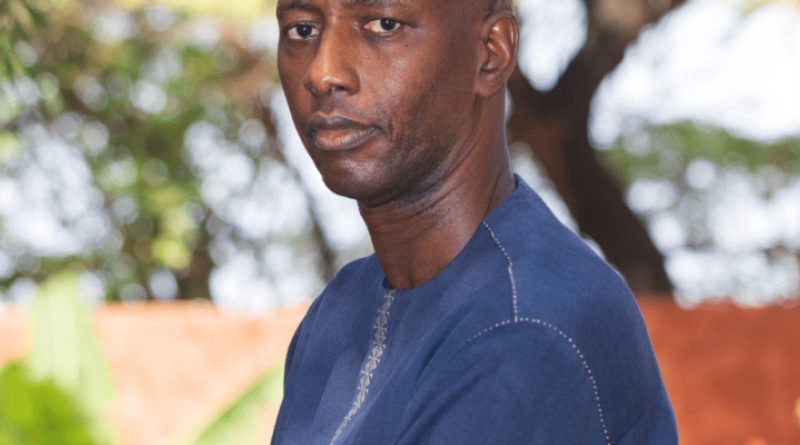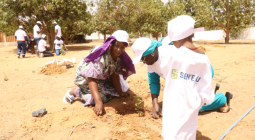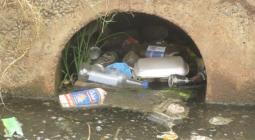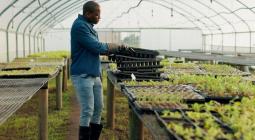Magatte Niang: “SEN’EAU is working for optimised water management in Senegal”

For his first media appearance since his appointment in August 2023, Magatte Niang chose Afrik21 to mark Africa Seas and Oceans Day. In this interview, the Director General of Eau du Sénégal (SEN'EAU) shares his vision of the challenges and successes in managing drinking water in Senegal, a country bordered by 700 km of coastline and particularly affected by the effects of climate change. Magatte Niang details the transformations that have taken place within SEN'EAU, the progress made in drinking water distribution, and the prospects for improvement in the years ahead.
Jean Marie Takouleu: Every year since 2015, Africa has been celebrating Seas and Oceans Day on 25 July. Your country, Senegal, has 700 km of coastline. What does this day mean to you?
Magatte Niang: As a Senegalese citizen and a player in public life, I have a special story because I come from a fishing family based in Guet Ndar in Saint-Louis. They are suffering from climate change, which is reflected in rising sea levels. The villagers are being forced to leave. Access to the ocean is also an issue, due to the privatisation of the coastline. Fortunately, the new authorities are carrying out a comprehensive project to ensure that everyone has access to the coastline and the ocean. I think this is important.
More generally, the international community must help the less developed countries to resolve these problems. Because there are emergencies just about everywhere: access to drinking water, healthcare, education, social services, and so on. What’s more, we’re going to have to deal with the consequences of climate change, which has been going on for a long time and for which we are not the main players. I think we need to show solidarity in this area and perhaps try to help localities that are suffering, such as my home town of Guet Ndar, so that people can continue fishing.
You’ve been at the helm of SEN’EAU (Eau du Sénégal) for almost a year now, and your company has been providing the public drinking water service in Senegal’s urban and peri-urban areas since 1 January 2020. What has really changed in the daily lives of Senegalese people in terms of drinking water supply?
We are proud to have solved the problem of water distribution and availability in all areas, particularly in Dakar. A few years ago, 403 districts in the capital lacked water. The people of Dakar only had water for a few hours during the day. The situation improved significantly with the commissioning of the third drinking water plant at Keur Momar Sarr (KMS3) in 2021, and since then we have reduced the number of neighbourhoods from 403 to around ten, which still experience water shortages, particularly during peak full stops when consumption peaks because of the rise in temperature with the heat, which has an impact on demand for water.
Thanks to the expertise of SEN’EAU’s staff, the ongoing transformation of our businesses and our equipment with the support of our technical partner SUEZ, the world leader in this field, combined with increased production and better control of production and distribution in addition to the constant renewal of the network, we also have control of flows with modelling that allows us to control our system. To date, 98% of the population of Dakar has access to water 24 hours a day, thanks to a 99% availability rate for the waterworks. Thanks to the extension of the network, 49,410 ordinary and social connections have been made in the capital Dakar alone, along with the installation of 51,419 sub-meters. Nationwide, 132,898 new connections have been made.
As mentioned earlier, we are experiencing some supply difficulties during periods of high demand in the higher areas. This problem will be resolved within 2 years, with the commissioning of the Mamelles seawater desalination plant. So 90% of the first challenge, which was to provide the population with quality drinking water, has been met in less than 5 years of SEN’EAU’s activities. In the other regions of Senegal, the situation has also been brought under control thanks to investment by the State via the SONES (Senegalese National Water Company), particularly in Thiès and Saint-Louis, where there were a number of water supply problems. It’s not just a question of producing water, but also distributing it. And to do that, we have the technical expertise and know-how to solve this problem everywhere. We are currently experiencing very hot weather in Dakar and we are still managing to meet customer demand.
Have there been any major technical changes?
If we look back four years, SEN’EAU has undergone a total transformation. The first is the transformation of all the business lines, which has enabled us to complete what we call job grading. Thanks to this reform, all the jobs, job descriptions and job titles have been changed so that we really are a water company. When I joined the Human Resources Department, everything was done on paper. To calculate an employee’s overtime, we would transport the paper documents to Dakar to be entered. Today, all our activities have been digitised.
Thanks to a policy of innovation, in particular technological innovation as part of the transformation of our businesses and processes, we can say that we have turned a corner. In four years, we have gained greater control over distribution and production with our Visio 360° tool, which provides us with a wide range of decision-making aids for managing flows and monitoring the network. We have also introduced electrochlorination, making us autonomous in our use of chlorine gas, which we have started to replace with locally produced salt for disinfection, and our main production site, KMS 1, 2 & 3, uses polymers as inputs.
For our customers, in addition to a new, simpler, more informative invoice, we have introduced the AAR SEN’EAU software. Our Customer Service Agents use tablets to make meter reading more reliable, as do our Network Service Agents. With G-ORDON, we are in the process of completing the network of the leased perimeter for scheduling our interventions from the Centre in Hann, our head office.
You mentioned the technical partner SUEZ, which has been working with SEN’EAU for over 4 years. What has it already brought you in terms of innovation in drinking water management?
The SUEZ Group is a major partner of the State in the creation of SEN’EAU, with 45% of the company’s capital. SUEZ is a world leader in the water and wastewater sector. The Group is helping us to transform our businesses and our production, distribution and customer tools. Its support enables us, in our day-to-day activities, to be on a larger scale than was previously the case. I spoke earlier about our control of our distribution and production processes with our Visio 360° tool, a highly innovative decision-making aid for managing flows and monitoring the network. Then there’s electrochlorination, which uses salt instead of chlorine to disinfect the water, and our main production site, KMS 1, 2 & 3, which uses polymer as an input. There’s also the AAR SEN’EAU customer software. Our field staff use tablets to make data more reliable, whether they’re reading customer meter readings or carrying out measurements to draw up estimates. With SUEZ, we have a tool called G-ORDON, which enables us to order all leak repair operations throughout the leased area from our head office in Dakar.
There is also the contribution of Technical Assistance and expatriates who have a level of experience likely to enable SEN’EAU to better manage the public drinking water service and become a benchmark in Africa in this area.
Are there any of these initiatives that could help to improve the supply of drinking water in rural areas?
The new authorities want rural and urban areas to be at the same level in terms of access to and supply of drinking water. To achieve this, our performance enables the Ministry of Water and Sanitation to know what still needs to be done. Otherwise, we are already providing support by supplying water in areas where there is a shortage, with a more social aim. And our role is to help wherever we can. That’s what the authorities want us to do. I know that there will be a second reform of the rural water sector, and we are going to take part in it to show that we can make a contribution. As part of this, SEN’EAU will be demonstrating its expertise in drinking water supply.
What is SEN’EAU’s relationship with Senegalese National Water Company(SONES) and the Senegalese government?
The governance of the drinking water sector in urban and peri-urban areas is carried out by three players: the State, which defines policy and administers water tariffs; SONES, a property company, which is responsible for developing the infrastructure (building plants, boreholes and distribution facilities); and the third player, SEN’EAU, whose main task is to manage and operate the facilities made available to it. To answer your question, SEN’EAU has annual and multi-year objectives that are set out in a performance contract. Within this framework, SEN’EAU must guarantee the quality of the water distributed in accordance with WHO recommendations, maintain the infrastructure to ensure 98% availability of production facilities, limit water losses to less than 15% from the sixth year of the leasing contract, renew 30,000 meters per year and 20,000 connections per year, and renew 60 kilometres of the 100 mm diameter ductile iron network every year. There is also the modernisation of the technical and commercial management of the public drinking water service in the area, in terms of production and distribution.
Senegal has one of the highest rates of access to drinking water in sub-Saharan Africa, with 98.7% in urban areas and 96.9% in rural areas, according to official figures. What are the main challenges facing SEN’EAU in the years ahead?
Senegal reached this level thanks to the first reform of the urban water sector in 1995-96. This was followed by the second, which led to the creation of SEN’EAU on 1 January 2020. This option for water governance has produced very good results, with an almost universal urban access rate of 98.7% and a continuous improvement in the public drinking water service. Rural areas are still lagging a little behind, but the authorities and players in the sector are working to get things moving so that citizens in urban and rural areas can enjoy the same quality of service in the distribution and production of drinking water.
The challenge now is to ensure that SEN’EAU’s services are equivalent to those in advanced countries. In France, where I had the opportunity to visit the water infrastructure, there is no break in the water supply. Our ambition is to be Senegal’s favourite water company over the next five years. The level of service must be high and constantly improved, from the production of drinking water to distribution, and even billing, which must be digitised.
In particular, this means introducing remote meter reading so that every customer can keep track of his or her consumption. An intelligent network also needs to be developed, so that the network can switch over automatically to compensate for water shortages in certain areas of high demand. This system already exists in many countries, including France. We will be working with our technical partner SUEZ to achieve this objective. We started this process 5 years ago, and we need to continue to modernise the company.
The next challenge is also water quality. SEN’EAU has just carried out a fresh water transfer in Mbacké in central Senegal, where the water contained a lot of fluoride, and people were already starting to complain about the situation. This transfer will continue to other towns affected by poor water quality. With the support of the State through SONES and our technical partner SUEZ, the next challenge is to provide very good quality water throughout Senegal, in line with World Health Organisation (WHO) standards.






